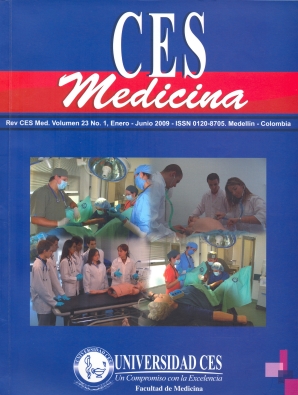ENDOMETRIOSIS INFILTRANTE: REVISIÓN DE TEMA / DEEP ENDOMETRIOSIS: A REVIEW
Resumen
La endometriosis infiltrante o profunda se define como la presencia de lesiones endometriales que infiltran el tejido más de 5mm, se ubican en el retroperitoneo en sitios diferentes a la endometriosis común y comprometen diferentes estructuras u órganos como intestino, uréter. vejiga, ligamentos útero sacros y región rectovaginal, pudiendo alterar la calidad de vida de la mujer. Los síntomas más frecuentes incluyen la dismenorrea, la dispareunia y la disquexia. Una aproximación al diagnóstico incluye la historia clínica con énfasis en los síntomas dolorosos de la endometriosis profunda, el examen físico con evaluación de la pelvis y las ayudas diagnósticas que dependen del sistema comprometido y que van desde la eco transvaginal, ecotransrectal y/o resonancia magnética, hasta el colon por enema con doble contraste y la urografía excretora o el urotac. La cirugía es la opción más efectiva para el tratamiento en el tiempo dependiendo del sitio de ubicación y el compromiso de los diferentes órganos; sin embargo, el tratamiento farmacológico es una conducta vigente y con indicaciones precisas que pudiera ser la opción principal o complementaria, a pesar de la recurrencias de los síntomas o de las lesiones. Dado que la endometriosis infiltran te o profunda es una enfermedad multisistémica, debe ser manejada por un equipo multidisciplinario. ABSTRACT This paper is a review of infiltrating or deep endometriosis and includes the definition, clinic, diagnostic tools and different options of medical and surgical treatment. Deep endometriosis is defined as the presence of endometrial injuries that infiltrate the tissue in more than 5mm. are located in the retro~peritoneum in different places than the common endometriosis which jeopardize different structures and organs such as: intestine. ureter. bladder. uterosacral ligaments and the rectovaginal area. being able to alter the woman's quality of life. The most frequent symptoms include dysmenorrhoea. dyspareunia and dysquexia. An approach to the diagnosis includes a good clinical history with emphasis in the painful symptoms. physical examination with pelvis evaluation and the diagnostic tools that depend on the jeopardized system and includes transvaginal ultrasound, transrectal ultrasound and/or magnetic resonance, colon by enema with double contrast and the excretory urography or urotae. Surgery is the most effective option for the treatment at this time. depending on the location and the involvement of the different organs; nevertheless, pharmacological treatment with precise indications is a valid conduct and could be the main or a complementary option, in spite of the recurrences of symptoms or injuries. Since the infiltrating or deep endometriosis is a multi-systemic disease. it must be handled by a multidisciplinary team.Descargas
Descargas
Publicado
Cómo citar
Número
Sección
Licencia
Derechos de reproducción (copyright)
Cada manuscrito se acompañará de una declaración en la que se especifique que los materiales son inéditos, que no han sido publicados anteriormente en formato impreso o electrónico y que no se presentarán a ningún otro medio antes de conocer la decisión de la revista. En todo caso, cualquier publicación anterior, sea en forma impresa o electrónica, deberá darse a conocer a la redacción por escrito.
Plagios, duplicaciones totales o parciales, traduccones del original a otro idioma son de responsabilidad exclusiva de los autores el envío.
Los autores adjuntarán una declaración firmada indicando que, si el manuscrito se acepta para su publicación, los derechos de reproducción son propiedad exclusiva de la Revista CES Medicina.
Se solicita a los autores que proporcionen la información completa acerca de cualquier beca o subvención recibida de una entidad comercial u otro grupo con intereses privados, u otro organismo, para costear parcial o totalmente el trabajo en que se basa el artículo.
Los autores tienen la responsabilidad de obtener los permisos necesarios para reproducir cualquier material protegido por derechos de reproducción. El manuscrito se acompañará de la carta original que otorgue ese permiso y en ella debe especificarse con exactitud el número del cuadro o figura o el texto exacto que se citará y cómo se usará, así como la referencia bibliográfica completa.
| Estadísticas de artículo | |
|---|---|
| Vistas de resúmenes | |
| Vistas de PDF | |
| Descargas de PDF | |
| Vistas de HTML | |
| Otras vistas | |



